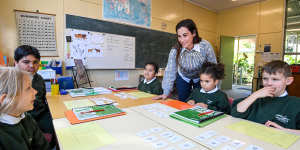A NSW Department of Education report on the $720 million program shows it boosted student confidence and motivation,but an academic evaluation – and how much it succeeded in narrowing the achievement gap – will not be completed until term one next year.

A group of students at Matraville Public School receive small-group tuition as part of the COVID-19 tutoring program.Peter Rae
The initiative,first proposed,was designed to help students catch up in core areas after massive learning disruptions.
NSW Minister for Education Sarah Mitchell said it had lifted students’ confidence and classroom engagement,and has given hundreds of trainee teachers hands-on classroom experience.
The report shows student confidence and engagement improved by 80 per cent,and motivation and attitude towards school had improved by 77 per cent and 69 per cent respectively. An academic evaluation of the program,that will draw upon check-in assessments to measure academic outcomes and additional assessments used by the schools,will be finished at the end of term one next year.
Matraville Public School principal Jenny Morrison said her school hired two teachers to run an intensive rolling 10-week intervention reading program.
“Our focus is on literacy,especially for the early years to make sure they were exposed to critical phonics learning they may have missed out on. It’s been easier to maintain maths skills,whereas reading,sounds,writing and public speaking are areas we need to see more growth in,” she said,noting that about a third of the year 1 cohort had slipped behind in reading during lockdown.
She said this year the school’s year 3 and year 5 NAPLAN results were pleasing,and there had been improvements from 2019 across the school.
Data up to August shows 5884 educators across NSW were employed as part of the program this year,with 64 per cent of those teachers,about 22 per cent teachers’ aides,about 8 per cent trainee or retired teachers and the remainder administrative or other support staff.
Last year,68 per cent of educators were teachers,11 per cent were teachers’ aides or learning support officers and 21 per cent trainee and retired teachers.

A NSW Auditor-General’s report released last year revealed staffing was one of the major challenges.
The latest report reveals “considerable challenges” with the program due to disrupted in-person learning and data collection.
”Analysis of student outcome data using check-in assessments was unable to determine the impact of participation on student achievement amongst those who participated in the program in 2021 ... due to significant disruption ... and the inconsistent reporting of students who participated,” the report said.
Julie Sonnemann,principal advisor education program director at the Grattan Institute,said employing teachers’ aides and trainees as tutors need the “correct supports,including training and well-structured materials,to have positive effects in small group tuition. If not well-supported,there can be risks to the quality.”
Sonnemann said Australia should look to the US in expanding research in tutoring, to examine the roll-out of small-group tuition programs and how well they help students catch up.
She said given the size of NSW’s COVID-19 tutoring initiative,it was vital parents and schools know how well it was working and governments should consider rolling out long-term,systematic catch-up tuition.
“The spread of ability in a regular classroom can be huge,and we now have an opportunity to know how well we are delivering intensive support interventions,so we can close the education gap.”
NSW Teachers Federation president Angelo Gavrielatos said the operation of the program was being severely impacted by the growing shortage of teachers.
“We are hearing constantly from schools that they either can’t staff this program or the teachers are regularly being diverted to classroom teaching because of the teacher shortages,” he said.
The Morning Edition newsletter is our guide to the day’s most important and interesting stories,analysis and insights..